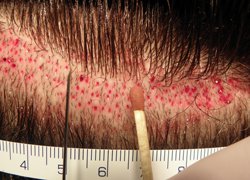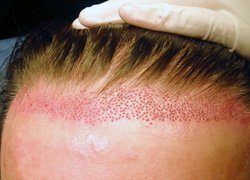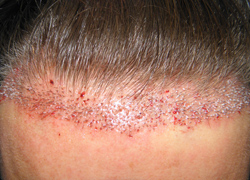Stages of gho-fm methodextracting grafts from the donor area preparing openings (holes) for the grafts implantation of the grafts into the holes |
The GHO-FM method, also known as FUE (Follicular unit extraction), was introduced in 2003 in the Netherlands. Currently, it is one of the most progressive methods of hair transplantation suitable for both men and women. In subsequent years, this method was perfected and further improved by Peter Hajduk, MD. and his team of experts.
Hair transplantation by GHO-FM is particularly suitable for those suffering from temple baldness at the front receding hairline and thinning scalp and hair thinning in women. A successful treatment is possible even in places that are completely hairless, such as scarring (loss of hair due to an accident, radiation, chemotherapy, burns, traction alopecia, or previous transplants using a Strip method).
In comparison with other methods, GHO-FM method appears to be much more gentle to the patient. It doesn´t use a scalpel, the skin is not cut and sewn again. This method utilizes micro-needles with a diameter of 0.60 and 0.65 mm.
Individual grafts are painlessly, after a gentle aenesthesia to the skin, one by one transferred by a small, specially developed needle from the donor area in the neck or on the sides above the ears. In the second part of the procedure, the grafts are implanted into small openings in the recipient area. The openings are of the same diameter as the sampling needle, so the grafts fit perfectly into the skin.
GHO-FM method offers more than just a transfer of hair. In fact, one can speak of a partial multiplication of hair follicles. Unlike all previously used methods, this method doesn´t allow the extraction of all hair follicles from the donor site. A small portion of the extracted follicular unit remains in the original donor area and there is a large, 60‒70% chance that a new follicle will grow in the original donor site.
GHO-FM method vs. strip method
The older methods called strip methods require a strip (or several strips) of skin to be cut with a scalpel from the donor site. They are then cut into small pieces (fragments), which must then be transferred into the transplanted recipient area. In particular, the first part of that procedure entails certain disadvantages:
-
a scar in the donor site which remains on the head for the rest of life and can hurt long after surgery. Due to the stroke of skin, the scars get usually spread over time and are more visible and in case this stroke affects the forehead, then the hairline can move back.
-
unnecessary reduction of potential donor sites, the exact number of grafts in the area cannot be estimated very precisely, i.e. the surgeon hardly knows how many grafts will be removed from the site. Due to the extraction technique, by the FUE (GHO-FM) method the surgeon can estimate the number of extracted grafts precisely.
-
depending on the experience of the expert removing a strip of skin with a scalpel and subsequently dividing it into fragments, there may occur a contusion to the tissue. This will reduce the quality of the grafts due to the prolonged exposure of the grafts to dry surroundings (outside the nutrient solution), thereby reducing the life of grafts.
Comparative table
|
We compare |
Strip methods |
GHO-FM method |
|
Removal of grafts from the donor area |
A strip of skin of various size is excised from the back of the head (roughly 3×17 cm).
|
We remove the grafts from the donor area with a GHO needle (0.60–0.65mm) one after another.
|
|
Skin desensitisation |
Local, injection |
Local, cooling and micro-injection through a special mesoapplicator |
|
Execution of openings in recipient area |
Laser, now little used.
|
By a micro-needle with a diameter of 0.60 to 0.65 mm, the same as by the graft extraction which guarantees a precise positioning of the graft in the opening and a proper healing.
|
|
Implantation of grafts |
Due to the tools used and their geometric shape, the grafts may not exactly fit into the holes.
|
As the same tools were used to extract the grafts and to prepare the openings, the grafts fit perfectly into the micro openings. |
|
Pain after treatment |
Pain in the donor area (scar) may outlast for several months, in rare cases even for years. |
The day following the treatment, patients do not feel pain in any area. There might be a slight burning and itching in the donor area caused by growing hair between the 6th to the 14th day following the treatment, no great pain. |
|
Final state of the recipient area |
The grafts do not have to fit exactly into the openings (a square into a square opening) which can result into a bumpy skin. |
The skin of the recipient area is smooth and the grafts create a naturally-looking hair.
|
|
Final state of the donor area |
A scar for the rest of your life. It may be nice and thin or may also extend and become painful. |
Traces of graft extraction by a needle with a diameter of 0.60–0.65 mm are almost invisible after healing. Since a part of stem structure of the follicular units was left in the donor area, some follicles regrow there. |
|
A number of possible transfered grafts per day (FU – follicular units) |
Facilities performing these methods advertise maximum 2 500 grafts per day. |
A good donor site (good hair thickness and quality) enables us to transfer maximum 1 300 grafts per day.* |
|
* GHO-FM method allows us to repeat the procedure even on the very next day. Thus, 3900 grafts, not hairs, may be transfered within three days. This is only possible in theory by older methods but practically it is not. There would have to be further excision of tissue in the donor area which would be already very difficult due to previous surgery. |




